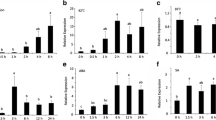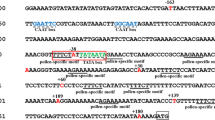Abstract
Sporamin and β-amylase are two major proteins of tuberous roots of sweet potato, and expression of genes coding for sporamin and β-amylase is induced concomitantly in leaves with the petioles attached by exogenous supply of sucrose or polygalacturonic acid. We have used a DNase I footprinting assay to characterize nuclear factors that bind to the 5′-upstream regions of gSPO-A1, gSPO-B1 and gβ-Amy genes that encode A-type sporamin, B-type sporamin and the subunit of β-amylase, respectively. Nuclear extracts from sucrose-treated petioles protected a region around -155 relative to the transcription start site of gSPO-A1 and a region around -880 of gβ-Amy from DNase I digestion on both strands. These two protected regions both contained the sequence ACTGTGTA, designated SP8a, in opposite orientation with respect to the direction of transcription. A gel mobility shift assay with SP8a oligonucleotide and competition experiments indicated that a common factor SP8BF binds to the SP8a sequence in gSPO-A1 and gβ-Amy. Binding of SP8BF to the SP8a oligonucleotide was abolished by mutation within the SP8a sequence. Fragments of the 5′-upstream region of gSPO-B1 also competed for the binding of SP8BF to the SP8a oligonucleotide, and the DNase I footprinting assay revealed three binding sites for SP8BF in the 5′-upstream region of gSPO-B1. These three sites in gSPO-B1 all contained the sequence TACTATT, designated SP8b, which shared 4 nucleotides at identical positions with the SP8a sequence. An inverted repeat of the SP8b sequence was also present at one protected site in the 5′-upstream region of gβ-Amy. In addition to sucrose-treated petioles, SP8BF activity was also present in tuberous roots and untreated fresh petioles of sweet potato. Furthermore, the activity was also detected in stems of tobacco plantlets, suggesting that SP8BF is an ubiquitous factor.
Similar content being viewed by others
References
Ausubel FM, Brent R, Kingston RE, Moore DD, Seidman JG, Smith JA, Struhl K. Current Protocols in Molecular Biology. John Wiley and sons, New York (1988).
Green PJ, Kay SA, Chua N-H: Sequence-specific interactions of a pea nuclear factor with light-responsive elements upstream of therbcS-3A gene. EMBO J 6: 2543–2549 (1987).
Hattori T, Fukumoto H, Nakagawa S, Nakamura K: Sucrose-induced expression of genes coding for the tuberous root storage protein, sporamin, of sweet potato in leaves and petioles. Plant Cell Physiol 32: 79–86 (1991).
Hattori T, Nakagawa S, Nakamura K: High-level expression of tuberous root storage protein genes of sweet potato in stems of plantlets grownin vitro on sucrose medium. Plant Mol Biol 14: 595–604 (1990).
Hattori T, Nakamura K: Genes coding for the major tuberous root protein of sweet potato: identification of putative regulatory sequence in the 5′ upstream region. Plant Mol Biol 11: 417–426 (1988).
Hattori T, Yoshida N, Nakamura K: Structural relationship among the members of a multigene family coding for the sweet potato tuberous root storage protein. Plant Mol Biol 13: 563–572 (1989).
Jefferson R, Goldsbrough A, Bevan M: Transcriptional regulation of a patatin-1 gene in potato. Plant Mol Biol 14: 995–1006 (1990).
Maeshima M, Sasaki T, Asahi T: Characterization of major proteins in sweet potato tuberous roots. Phytochemistry 24: 1899–1902 (1985).
Maxam AM, Gilbert W: A new method for sequencing DNA. Proc Natl Acad Sci USA 74: 560–564 (1977).
Murashige T, Skoog F: A revised medium for rapid growth and bioassay with tobacco tissue cultures. Physiol Plant 15: 473–497 (1962).
Nakamura K, Ohto M, Yoshida N, Nakamura K: Sucrose-induced accumulation of β-amylase occurs concomitant with the accumulation of starch and sporamin in leaf-petiole cuttings of sweet potato. Plant Physiol 96: 902–909 (1991).
Ohta S, Hattori T, Morikami A, Nakamura K: High-level expression of a sweet potato sporamin gene promoter: β-glucuronidase (GUS) fusion gene in the stems of transgenic tobacco plants is conferred by multiple cell type-specific regulatory elements. Mol Gen Genet 225: 369–378 (1991).
Rocha-Sosa M, Sonnewald U, Frommer W, Stratmann M, Schell J, Willmitzer L: Both developmental and metabolic signals activate the promoter of a class I patatin gene. EMBO J 8: 23–29 (1989).
Ryan CA: Oligosaccharide signalling in plants. Annu Rev Cell Biol 3: 295–317 (1987).
Sambrook J, Fritsch EF, Maniatis T: Molecular Cloning: A Laboratory Manual, 2nd ed. Cold Spring Harbor Laboratory Press, Cold Spring Harbor, NY (1989).
Sommer H, Bonas U, Saedler H: Transposon-induced alterations in the promoter region affect transcription of the chalcone synthase gene ofAntirrhinum majus. Mol Gen Genet 211: 49–55 (1988).
van derMeer IM, Spelt CE, Mol JNM, Stuitje AR: Promoter analysis of the chalcone synthase (chsA) gene ofPetunia hybrida: a 67 bp promoter region directs flower-specific expression. Plant Mol Biol 15: 95–109 (1990).
Wenzler HC, Mignery GA, Fisher LM, Park WD: Analysis of a chimeric class-I patatin-GUS gene in transgenic potato plants: High-level expression in tubers and sucrose-inducible expression in cultured leaf and stem explants. Plant Mol Biol 12: 41–50 (1989).
Wentzler H, Mignery G, Fisher L, Park WD: Sucrose-regulated expression of a chimeric potato tuber gene in leaves of transgenic tobacco plants. Plant Mol Biol 13: 347–354 (1989).
Yoshida N, Nakamura K: Molecular cloning and expression inEscherichia coli of cDNA encoding the subunit of sweet potato β-amylase. J Biochem (Tokyo) 110: 196–201. (1991).
Author information
Authors and Affiliations
Rights and permissions
About this article
Cite this article
Ishiguro, S., Nakamura, K. The nuclear factor SP8BF binds to the 5′-upstream regions of three different genes coding for major proteins of sweet potato tuberous roots. Plant Mol Biol 18, 97–108 (1992). https://doi.org/10.1007/BF00018460
Received:
Accepted:
Issue Date:
DOI: https://doi.org/10.1007/BF00018460




